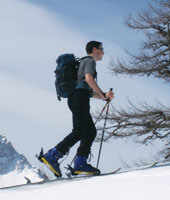

Regular physical activity improves your health, well-being, and quality of life. Both cross-country and alpine skiing exude a physiological and psychological rush that allows you to temporarily escape from the stresses of the world.
While skiing is a technical and physical recreational sport requiring concentration and skill, the beauty of the sport can be experienced by people of all ages. It is estimated that there are over 200 million skiers worldwide. dedecms.com
Cross-country skiing is easier on the joints and provides an exhilarating cardiovascular workout involving effort by both the upper and lower body. Downhill skiing is also an excellent aerobic workout but requires a higher level of strength, coordination, balance, and agility. ��������dedecms
In the various forms of professional skiing, including cross-country, downhill, moguls, and slalom events, the highest level of fitness is required to compete. ��������֯��
Reduce Your Risk of Injury ֯�κã���֯��
The level of skill, balance, and coordination required for skiing makes it a very unique activity. Unlike most recreational sports, skiing should not be used to improve one’s shape or fitness. Instead, you should make sure you are fit before the skiing season starts.
��������dedecms
New binding technology and shoe design have decreased the incidence of lower leg injures over the past 30 years, but knee sprains and injuries to the shoulders and thumbs are still common among skiers. Injury can be reduced by adequately preparing the body for the physical challenges of skiing. ֯�κã���֯��
The goal of all recreational sports is to have fun, and skiing is no different. A moderate training program, combined with some common-sense decisions, can add years of skiing fun to your life with minimal injury or muscle pain.
Top Four Steps to Consider
Prepare your body for skiing: The first ski slope is neither the time nor the place to begin a vigorous training program. Instead, start a training program aimed at improving flexibility, strength, endurance, and cardiovascular conditioning at least two to three months before hitting the slopes. A circuit training program that combines eight to 12 exercises performed one after another will help improve cardiovascular fitness and muscular endurance. It also strengthens tissues surrounding joints in preparation for the joint stress of landing, turning, and twisting. In addition, cardiovascular activity, such as running or cycling three to four times per week for 30 to 45 minutes, will help you maintain energy on the slopes. ��������dedecms
Stretch as often as possible: A stretching program should be practised prior to the ski season and before and after each skiing event. A warm muscle contracts quicker and is better able to handle the stress of the activity. Before doing a 15- to 20-minute stretching routine for the legs, lower back, shoulders, and calves, warm up by skipping or running on the spot for five to 10 minutes to increase blood flow and body temperature. After the skiing activity, your muscles will be really tight and rigid, so stretching is the best way to restore elasticity to the muscles and prevent muscle soreness.
dedecms.com
Seek professional help: Some people attempt to teach themselves how to ski or ask a friend to show them proper skiing techniques. Often, injury occurs simply due to a lack of skilled technique. An instructor or professional skier can teach you how to avoid injury, how to properly fit the equipment to your body, and how to lessen the impact if you find yourself in an awkward situation. ֯�κã���֯��
Strengthen your core: The core area connects your upper and lower body together and thus acts as the weakest link. The stronger your abdominals and lower back, the better you are able to dissipate stress, maintain proper skiing posture, and avoid fatigue. ��������dedecms

